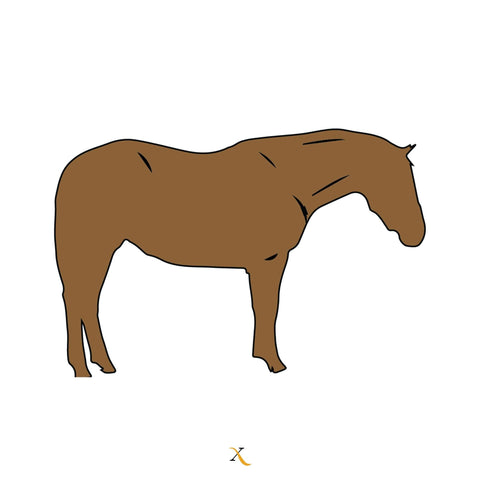6 Areas Of Fat Deposition On Your Horse




Determine 1-9 Body Score

The Body Score system takes into account the amount of fat compared to muscle in each of the 6 regions from Step 1. This system ranges from 1 (poor) - 9 (extremely fat).
BCS 1: Poor

No fatty tissue can be felt, and bony structures such as the ribs, spine, withers, shoulder, and neck are easily seen.
2: Very Thin

A slight amount of fat covers the base of the spine (between areas 2 and 5). Areas 4-6 are prominent, while areas 1-3 are less concerning.
3: Thin

The tail head (area 6) is prominent, while the rump and rib covering appear rounder. There is a slight fat cover over the ribs, however, they are still apparent.
4: Moderately Thin

The base of the spine appears to have a negative crease (between areas 2 and 5), and a faint outline of ribs is apparent. However, the neck, withers, and shoulders are no longer thin (areas 1-3).
5: Moderate

Tailhead has a layer of fat that feels spongy. Ribs are not visible but can be felt through a thin layer of fat. Withers appear to be rounded, and the neck/shoulders blend smoothly into the horse's body.
6: Moderately Fleshy

Fat around tailhead is soft, and fat over the ribs feels spongy. Fat is beginning to form behind the shoulders, and sides of the neck and withers.
7: Fleshy

Ribs can be felt, however, there is noticeable fat between ribs. Fat around the tailhead, neck, withers, and behind the shoulder are more apparent and soft.
8: Fat

Tailhead far is very soft and a positive crease is formed down the spine. Ribs are difficult to feel and the shoulder crease is now flush with the body. There is a noticeable thickening of the next, and fat deposits along the rump area.
9: Extremely Fat

Bulging fat around tailhead, ribs, neck, withers, and shoulder. There is an obvious positive crease down the back, and fat along the inner buttocks may rub together.
How To Improve Your Horse's Body Condition Score
While the ideal body score for a horse is 5, most horse owners find that their horses can range anywhere from 3-7. According to a recent study from the Journal of Equine Veterinary Science, 40% of horses and ponies are considered overweight. And with equine obesity on the rise, it is important to understand where your horse falls on the BCS scale.
Adjust Dietary Balance
Adjusting dietary balance is commonly the first step in adjusting BCS in your horse. Depending on where your horse falls on the 1-9 scale, they may need to shed some pounds, or gain weight.
Poor To Moderate Body Condition

Adding balanced Omega-3 and Omega-6 Fatty Acids (Excel ProElite) to a fiber-rich diet helps your horse begin to build healthy fat components.
Moderately Fleshy To Extremely Fat

Adjusting your horse’s caloric intake and increasing exercise is key to weight loss. First, overweight horses should NOT be fed large amounts of grains or concentrated feeds in one serving. It is suggested, instead, that horse owners should feed a ration balancer or low-calorie, low-fat, low-sugar/starch feed in small amounts.
Improve BCS With Exercise
Above all, exercise is the most important factor for horses' who have a body score of 6 or higher. First, build a strength-focused workout routine that is appropriate to your horse’s current body condition. These strength-building exercises should consist of gradual work that increases in both difficulty and stamina during each training session.
With that being said, also remember to build in "recovery" days to allow your horse’s body to rest.







